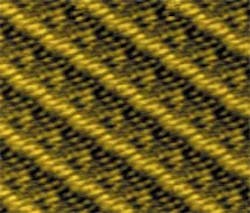Somewhere between a solid and a liquid, nematic liquid crystal (LC) is characterized by molecules that retain parallel alignment of the longitudinal axes but can flow like a fluid, for temperatures below a critical LC "melting" point. It has been theorized for decades that the ordered crystallization of such fluid-like molecules could form a solid "bridge" across a narrow gap between two plates under certain conditions, even above the critical temperature. Such bridges could be useful in applications such as optics with self-arranging crystals.1 Detecting this LC behavior, however, has been a challenge because it could only occur over a small range of temperatures and plate separations.
Scientists at the University of Ljubljana and the J. Stefan Institute (both Ljubljana, Slovenia) have announced the first measurement of these properties of LC using an atomic force microscope (AFM). The researchers showed that a drop of warm liquid between two glass surfaces spontaneously forms a liquid-crystal bridge when the surfaces get close enough and the temperature is near the isotropic-nematic phase transition temperature, TTo do this, the team treated the surfaces of a glass microsphere and a flat glass plate with a chemical that created a monolayer of aligned molecules. They then placed a drop of liquid between the two surfaces and used an AFM to gradually reduce the surface separation between the microsphere and the plate. The team reported a strong capillary force over "extraordinarily large surface separations" of several hundreds of nanometers. The critical point of capillary phase transition happened at a separation of 5 to 10 nm. When a bridge formed, it tugged the two surfaces together, and the researchers measured the pull with the AFM. The temperature at the critical point was found to be about 0.5 K above T
The team's success is attributed to the novel use of AFM technology to measure the LC bridges, the first technique with adequate sensitivity. Igor Musevic, professor of mathematics and physics, said that he and his colleagues believe that the crystal bridge phenomenon could someday connect microscopic beads in a lattice structure that would reflect or transmit certain wavelengths of lighta so-called photonic crystal. "Photonic bandgap materials based on dispersions of solid or liquid particles in liquid crystals might be built under fine control of the capillary attractive force, as observed in our experiments.
"These systems have attracted great interest recently, due to predicted novel electro-optic properties," said Musevic, "but we also hope this work will trigger people to find additional applications."
REFERENCES
- D.Kang et al., Phys. Rev. Lett. 86, 4052 (2001).
- K. Kocevar, A. Borstnik, I. Musevic, and S. Zumer, Phys. Rev. Lett. 86, 5914 (2001).
About the Author
Valerie Coffey-Rosich
Contributing Editor
Valerie Coffey-Rosich is a freelance science and technology writer and editor and a contributing editor for Laser Focus World; she previously served as an Associate Technical Editor (2000-2003) and a Senior Technical Editor (2007-2008) for Laser Focus World.
Valerie holds a BS in physics from the University of Nevada, Reno, and an MA in astronomy from Boston University. She specializes in editing and writing about optics, photonics, astronomy, and physics in academic, reference, and business-to-business publications. In addition to Laser Focus World, her work has appeared online and in print for clients such as the American Institute of Physics, American Heritage Dictionary, BioPhotonics, Encyclopedia Britannica, EuroPhotonics, the Optical Society of America, Photonics Focus, Photonics Spectra, Sky & Telescope, and many others. She is based in Palm Springs, California.

